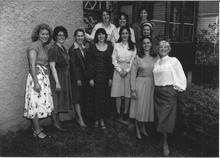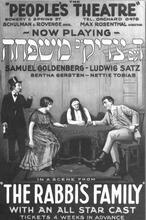Libby Holman
Libby Holman, July 9, 1932.
Courtesy of the Library of Congress/Wikimedia Commons.
Libby Holman was known as much for her scandalous personal life and revolutionary activism as for her lush voice. Holman moved to New York to become an actress and singer. She performed her first major role in 1925 in The Sapphire Ring and continued to perform in shows and revues throughout the twenties. Holman was openly bisexual and was accused of murdering her husband, Zachary Smith Reynolds, in 1932, a case that became the basis for Hollywood films. Holman first sang her trademark song “Moanin’ Low” in 1929, part of her lifelong focus on African American music and culture. She protested segregation by performing with African American musician Josh White. In later life, she was a friend and supporter of Dr. Martin Luther King, Jr.
“I always have to break a song over my back. … I just can’t sing a song; it has to be part of my marrow and bones and everything,” Libby Holman explained in a 1966 interview. Daring, dark, and impetuous, Holman led a rich public life that touched a dizzying array of people, from Martin Luther King, Jr. to Montgomery Clift, from Alice B. Toklas to Jane Bowles. A musical and sexual revolutionary from the 1920s to the 1960s, Holman succeeded at two different musical careers. Known as the “Statue of Libby,” she carried one of the smokiest torches of American music hall society in the 1920s and 1930s, and was the inventor of the strapless evening dress. From a deep sense of personal commitment, she later made significant contributions to the civil rights movement as both an artist and a wealthy benefactor. However, murder, millionaires, death, and suicide were morbid recurring themes in Libby Holman’s life, reaching tabloid proportions.
Early Life and Family
She was born Elizabeth Lloyd Holzman at home in Cincinnati, Ohio, on May 23, 1904, to middle-class parents of German Jewish descent. Libby, younger brother Alfred, and older sister Marion were not raised in the Jewish faith. Alfred Holzman, a lawyer/stockbroker and Rachel (Workum) Holzman, a schoolteacher, had converted to the Christian Science church.
In 1923, after completing a major in French in three years, Libby Holman was the youngest woman to graduate from the University of Cincinnati. At nineteen, still too young to attend law school as she planned, she moved to New York with dreams of Broadway.
Acting Career in New York
In 1925, she landed her first significant role in the play The Sapphire Ring and soon after joined the road company of The Greenwich Village Follies. Her big break came in Richard Rodgers and Lorenz Hart’s musical revue, The Garrick Gaieties (1925), which ran over 211 performances. Her nearsightedness provided an unexpectedly alluring stage persona, while her palate, an eighth of an inch askew, helped produce her strangely throaty sustained laments and a grunting style she liked to call her “vomit.” Holman, now a minor celebrity, landed roles in Merry-Go-Round (1927), Rainbow (1928), and Gambols (1929). Entrenched in New York’s bohemian, Prohibition dance-and-bathtub-gin culture, Holman swore, drank, and made regular late-night excursions to Harlem’s Cotton Club and Inferno.
In 1929, she sang her trademark torch song, “Moanin’ Low,” in Clifton Webb’s The Little Show. Framed by a theatrical sketch in which Holman played a two-timing “mulatto” lover, “Moanin’ Low” made her a legend. Her unusual basso contralto, Betty Boop lips, and untraditional beauty created what Times critic Brooks Atkinson labeled a “dark purple menace.” Many people believed that Holman was a “Negro” who passed as white, because of her rich black hair, dark skin, and “racial” style of singing. She always insisted, “Nothing could have pleased me more.” Inspired by her musical admiration for singers such as Ethel Waters, Holman cultivated racial ambiguity in her art.
During this period, Clifton Webb introduced Holman to Louisa Carpenter, a millionaire member of the du Pont family. By the time Howard Dietz and Arthur Schwartz’s Three’s a Crowd opened at the Selwyn Theater on October 15, 1930, Carpenter and Holman had become inseparable lovers. Her bisexuality became the talk of Broadway, only the first of many tabloid scandals she inspired in the thirties. Costarring with Fred Allen, Holman sang “Give Me Something to Remember You By” and “Body and Soul.” The latter was banned from the radio for obscenity but became one of the best-selling records of the time and the song most identified with Holman throughout her career.
Reynolds Case
Zachary Smith Reynolds, heir to the R.J. Reynolds tobacco fortune began, literally, to follow Holman’s career. An aviator, he flew from city to city courting her attention until November 16, 1931, when, just a few days after his divorce from Anne Cannon was finalized, the two were married by a justice of the peace in Monroe, Michigan. The famously ill-fated marriage ended tragically at the Reynolds estate, “Reynolda,” near Winston-Salem, North Carolina. On July 5, 1932, Reynolds was shot in his bedroom; he died the next morning in the hospital and the coroner declared the death a suicide. Even after being presented with accusations of tampered evidence, two antisemitic grand juries approved murder charges against Holman, who had been with Reynolds at the time of the shooting, and against Ab Walker, Reynolds’s best friend.
Holman went into hiding with Louisa Carpenter, and eventually the case was dropped through the influence of the Reynolds family. When Holman gave birth on January 9, 1933, to Christopher “Topper” Reynolds, it brought a new heir to the R. J. Reynolds tobacco fortune and became one of the biggest news stories of the year, later inspiring two Hollywood scandal films, Reckless, starring Jean Harlow (1935) and Written on the Wind (1956).
Later Career and Activism
Although she returned briefly to Broadway in 1934, in Revenge with Music, singing Arthur Schwartz and Howard Dietz’s “You and the Night and the Music,” Holman was becoming vehemently anti–Tin Pan Alley. Cole Porter’s You Never Know in 1938 was the last musical in which she appeared. Unfortunately, Reynolds’s death was only the first in a series of tragic events. In 1939, Holman married a second time, to Ralph de Rimer Holmes, an actor who spent most of the marriage at war and committed suicide soon after his return. On her own, Holman adopted two sons at birth: Tim (b. 1945) and Tony (b. 1947). Soon after, in August 1950, her first son, Topper, died climbing a mountain.
In 1941, Holman met Leadbelly and Josh White at a Greenwich Village nightclub. For the next four years, as Holman’s guitar accompanist, White interested her in adapting songs previously sung only by black performers. Building on her earlier cross-over career, Holman researched American folk and blues songs at the Library of Congress, making use of the Lomax field recordings.
In 1947, Gerald Cook became her primary mentor and co-artist in this enterprise, composing and rearranging songs she referred to as “Earth Songs.” Their highly theatrical collaborative performance, Blues, Ballads and Sin Songs, included lyrics by Tennessee Williams and Paul Bowles, and made three continental tours. Mainbocher designed her trademark floor-length skirt, which served as a prop. She also used a small chair dramatically to suggest prison bars at one moment and an executioner’s block the next. Among their last appearances were a UNICEF Concert (1965), a Georgetown University benefit concert for civil rights (1966), and a World Federation of United Nations Association Benefit (1968). Embracing a Jewishness she had at times denied, Holman also made a point of accepting the invitation of the mayor of Jerusalem to perform at the first anniversary of the city’s new museum.
Libby Holman adopted and practiced Zen at the end of her life, and when, on June 18, 1971, she apparently committed suicide at her Connecticut estate “Treetops,” a Quaker service was held in her memory. She was survived by her third husband, New York sculptor Louis Schanker, as well as her two adopted sons. The latter half of her life had been devoted to social and philanthropic activities. In Topper’s memory, Holman founded in 1952 the Christopher Reynolds Foundation, which financed her friend Martin Luther King, Jr.’s visit to India to meet with followers of Mahatma Gandhi, and is still devoted to civil rights, peace, and disarmament programs. In 1962, Holman established the Libby Holman Foundation, which funds arts and cultural programs for the disadvantaged.
Selected Works by Libby Holman
Blues Till Dawn, with Josh White. Decca (1942).
Body and Soul. From Three’s a Crowd. Brunswick 4910 (1930).
The Legendary Libby Holman, with Gerald Cook. Evergreen MRS 6501 (1965).
Libby Holman: Moanin’ Low (Early Recordings 1927–1934). Take Two Records (1995).
Libby Holman Sings, with Gerald Cook. MB 101 (1953).
Libby Holman Sings Blues, Ballads and Sin Songs, with Gerald Cook. MB 102 (1954).
Moanin’ Low. From The Little Show. Brunswick 4445 (1929).
Original Cast! 100 Years of the American Musical Theater. The Thirties. MET 802 (1995).
Something to Remember Her By, with Gerald Cook. Monmouth Evergreen MES/7067 (1954).
You’re the Top: Cole Porter in the 1930’s. Indiana Historical Society (1992).
Bradshaw, Jon. Dreams That Money Can Buy: The Tragic Life of Libby Holman (1985).
Holman, Libby. Interview by Arlene Francis. Radio Broadcast WOR NY, January 26, 1966, and Interview by Richard Lamparski, “Whatever Became of ... Libby Holman,” Radio Broadcast WBAI, January 31, 1966, and interview by Duncan McDonald. Radio Broadcast WQXR, November 10, 1965.
“Libby Holman Goes into New Seclusion.” NYTimes, August 10, 1932, 3:1.
Machlin, Milt. Libby (1980); “Open Verdict Given in Reynolds Death: Widow Is Released.” NYTimes, July 12, 1932, 1:3.
Perry, Hamilton Darby. Libby Holman: Body and Soul (1983).
“Says Libby Holman Asks ‘Modest Sum.’” NYTimes, January 14, 1933, 30:8.
“Seek Libby Holman in Delaware Home.” NYTimes, August 6, 1932, 1:4.
Wilson, John S. “Libby Holman Sings at U.N. Next Week: Her First Time Here in 11 Years.” NYTimes, October 30, 1965, 38:2.





